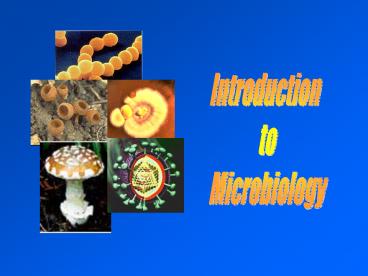to - PowerPoint PPT Presentation
1 / 40
Title:
to
Description:
Microbiology as a science began with the development of the Microscope. Anton van Leeuwenhoek (1632 ... Foundation of modern Microbiology. Koch's postulates ... – PowerPoint PPT presentation
Number of Views:20
Avg rating:3.0/5.0
Title: to
1
Introduction to Microbiology
2
Microorganisms
- living things ordinarily too small to be seen
without magnification
Bacteria Fungi (yeast mold) Protozoa
Viruses Algae
Which one is not prokaryote?
3
Size of micro-organisms
4
Foundation of modern Microbiology
- Microbiology as a science began with the
development of the Microscope - Anton van Leeuwenhoek (1632-1723) father of
microbiology - Microorganisms and spontaneous generation
5
Foundation of modern Microbiology
- Louis Pasteur (1822-1895) m.o.
- in spoiled food is the same as in the air
- The Germ theory
- Robert Koch (1843-1910)
- Kochs experiment
6
(No Transcript)
7
Kochs postulates
- 1. The specific m.o. should be shown to be
present in all cases of the disease. - 2. The specific m.o. should be isolated from the
diseased host and grown in pure culture. - 3. These freshly isolated m.o., when inoculated
into a healthy, susceptible host, should cause
the same disease seen in the original host. - 4. The m.o. should be reisolated in pure culture
from the experimental infection.
8
Microscopy
- Light microscope
- uses light as sources of illumination
- bright-field
- dark-field
- fluorescence
- phase-contrast
9
Microscopy
10
(No Transcript)
11
Fluorescence use an ultra-violet source of
illumination that cause fluorescent microbes to
emit light
Confocal use laser light to illuminate one
plane of a specimen at a time to obtain 2- and
3-dimensional images of cells
12
Electron microscope
Microscopy
- electron beam light waves
- electromagnetic lens
- glass lens
- transmission electron microscopes (TEMs)
- scanning electron microscopes (SEMs)
13
Microscopy
SEM
TEM
14
(No Transcript)
15
The Procaryotic Cell
16
Cell Morphology
Spherical
17
Cell Morphology
Rod
18
Cell Morphology
Spirochetes
19
Composition and Structure
- Macromolecules chemical composition
- Proteins amino acids polypeptides
- primary structure
- secondary structure beta sheet alpha helical
- tertiary structure
- quaternary structure
- Nucleic acids DNA RNA
- Carbohydrates mono-, di-, polysaccharides
- Lipids fats, phospholypids and steroids
20
Cell wall
- gram negative lipopoly-
- saccharides
- gram positive peptidoglycan
NAM N-acetyl muramic acid NAG N-acetyl
glucosamine
peptidoglycan
21
Cell wall
gram positive bacterial cell wall
22
Cell wall
gram negative bacterial cell wall
23
Cell wall staining
- simple, differential, or special
- Gram stain
Gram positive
Gram negative
Acid fast
24
Cytoplasmic membrane
Glycoprotein (Glycophorin A, Protein 3)
Cholesterol
Integral Protein
Extracellular
Intracellular
Peripheral Protein (Ankyrin)
Aminophospholipid
Choline Phospholipid
Peripheral Protein
Cytoskeleton
Actin
Spectin
25
Ribosome
tRNA
Large subunit
Small subunit
26
Flagella
locomotion
monotrichous
lophotrichous
peritrichous
27
Axial filament
28
Pili
- straight hair-like appendages - function
attach bacteria to other cell attaches
one bacterial cell to another during
mating
29
Endospores
- occurs almost exclusively in G ve bacteria
- a dormant form of life and generally produced
- when conditions are not appropriate for
- vegetative cell growth
- are very resistant to
- killing by physical and
- chemical agents
30
Storage granules
- glycogen (starch granules) - polyhydroxy
alkanoates (PHA) - polyphosphate (volutin) -
sulfur granules - Gas Vacuoles
31
The Eucaryotic cell
32
Nucleus
33
Endoplasmic recticulum
- rough ER
- smooth ER
34
Golgi apparatus
35
Mitochondria
36
Chloroplast
37
Chromosome
metaphase
38
Chromosome and DNA
39
Lyzosome
40
Centriole































